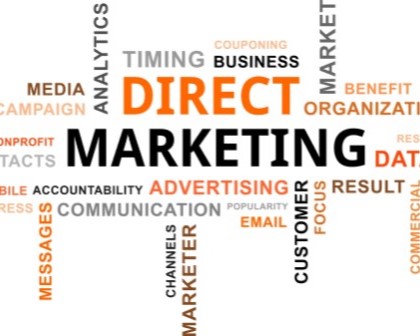Marketing and Sales should work hand in hand. You cannot have one without the other

Sales or Marketing – Banks Need Both to Grow Revenues
You could easily make the case that salespeople have the toughest job in any organization. They’re under constant pressure to increase sales while facing unbending resistance from customers and prospects. If you’re organization relies on your salesforce for growth, you certainly don’t want to make their job more difficult than it already is. However, while maybe not intentional, some banks do exactly that by not providing their bankers with what they need—real marketing support.
Regardless of the industry, organizations that fail to provide marketing support to their sales teams tend to struggle in growing revenues. What many neglect to understand is that it takes a robust marketing campaign to increase brand awareness that helps its salesforce to bring customers and prospects in the door. An effective marketing strategy provides high-value support by generating new leads and cultivating them into qualified prospects for the sales team to contact.
Sales Support and Marketing Support are not the Same
It’s not usually the case that a bank deliberately withholds marketing support, because most banks understand the importance of marketing in growing their business. Typically, banks tend to conflate marketing and sales support in terms of the support their sales teams need to do their job and the outcomes they expect for investing in that support.
For example, many banks create “sales” collateral focusing on products and services to be used by their sales teams in face-to-face meetings with prospects. Then they wonder why their “marketing” isn’t attracting enough new leads and their salespeople aren’t closing more business. It’s because that isn’t marketing. It’s sales.
This scenario is not uncommon among banks, which tend to be more marketing-oriented than sales-oriented. In many cases their sales and marketing functions are combined in one department under a person with more of a marketing background. It can also be a function of limited resources, where a bank sees marketing support as a better investment than sales support.
It Takes a Well-Oiled Marketing Strategy to Drive Sales Growth
That’s understandable considering that sales is a linear process with tangible outcomes that can be easily measured. It’s about closing deals and bringing revenue today. Marketing involves strategies that take time to ramp up and the results come in the future.
Sales is everything that happens in the sales funnel, from contacting a lead to presentation to closing the sale. Marketing is responsible for getting more leads into the funnel and empowering their sales teams by creating a compelling story, building the brand and creating an environment in which their reputation precedes them when they call on a prospect.
The data collected along the way let’s salespeople know who’s engaging, how they are engaging and their level of interest, so they can contact the right people at the right time with the right idea. That’s how marketing supports salespeople and increases the firm’s ROI.
Sales and Marketing – Can’t Have Success with One without the Other
The bottom line is that effective marketing creates more sales and generates more revenue, but the two must function simultaneously for optimum results. If salespeople are the linchpin of a firm’s revenue growth, marketing is the engine that keeps leads flowing. Add in a well-conceived public relations and communications strategy to tell the bank’s story and increase brand awareness then watch the confidence level and production of your salesforce soar.
Recent articles:

Managing Debt Effectively for Small Business Owners: A 2026 Guide - Debt doesn’t have to hold your business back. With clear insight, smart repayment, and proactive planning, you can turn borrowing into a growth tool—not a burden.

Building Strategic Partnerships for Small Business Success - Strategic partnerships amplify reach, reduce risk, and accelerate growth—proving small businesses go further, faster when they build together.

Embracing Micro-Influencer Marketing for Small Businesses - Micro-influencers give small businesses authentic reach, higher engagement, and real sales—proving that trust, not size, drives modern marketing.

Using Financial Software to Streamline Small Business Bookkeeping - Automating your bookkeeping saves time, reduces errors, and gives you real-time insights—so you can focus on growth, not data entry.

Using Data Analytics to Drive Small Business Decisions - Data analytics empowers small businesses to make smarter decisions, cut costs, improve marketing, and stay competitive in today’s fast-paced market.

The Rise of Hybrid Work Models for Small Businesses - Hybrid work helps small businesses attract talent, save costs, and stay competitive, making flexibility a key driver of growth in 2025 and beyond.
Previous Articles:
- Adapting to Changing Consumer Behaviors in 2025: Essential Steps for Small Businesses
- Crafting a Realistic Cash Flow Forecast for 2025: A Guide for Small Businesses
- Elevate Your Business with Flexible Payment Options for Customers
- Understanding and Optimizing Your Business Credit Score
- The ROI of Automation: Affordable Tech Solutions for Small Business Growth
- High-Impact, Low-Cost Marketing Ideas for Small Businesses
- The Small Business Owner’s Guide to Managing Stress and Avoiding Burnout
- With Credit Tightening, How Small Businesses Can Build a Strong Financial Profile
- Post-COVID Trends That Small Businesses Can’t Afford to Ignore
- Standing Out in a Saturated Market: Tips for Small Business Differentiation
- Tightening the Belt: 10 Cost-Cutting Strategies for Small Businesses Facing Rising Expenses
- Five Steps Small Businesses Can Take to Increase Web Traffic
- Retention 101: Keeping Your Best Employees in a Competitive Market
- Creative Ways to Overcome Labor Shortages in Your Industry
- Preparing Your Business for the Next Recession: Actionable Tips
- 2025 Tax Updates for Small Businesses: What You Need to Know
- Email Marketing Mistakes Businesses Must Avoid
- Why Community Engagement is Crucial for Small Businesses
- Adapting to E-commerce: A Guide for Brick-and-Mortar Stores
- Harnessing the Power of Customer Reviews to Boost Your Business
- Small Business Owners Need an Integrated Approach to Post-Pandemic Financial Planning
- How to Build a Strong Brand Identity on a Budget
- The Future of Remote Work: Tips for Small Businesses to Thrive
- Navigating the Gig Economy: Opportunities and Challenges for Small Businesses
- Sustainable Business Practices: How Small Businesses Can Make a Big Impact
- 10 Essential Free Tools for Small Businesses
- 7 Ways Small Businesses Can Benefit from AI and Automation
- How to Leverage Social Media for Your Small Business in 2024
- The AI Advantage: How Small Businesses Can Thrive in the Age of Intelligence
- Shielding Your Business: Essential Insurance for Risk Management
- How Outsourcing Can Help Your Small Business Grow
- Securing Your Data: A Cloud Security Checklist for Small Businesses
- Mastering Cash Flow: How Banks Empower Small Businesses with Cash Management Tools
- Optimizing Productivity for a Remote Workforce
- Digital Strategies: The Engine of a Virtual Distribution Strategy
- Attracting and Engaging Gen Z: The Future of Your Workforce
- Managing Cash Flow for Business Prosperity
- How to Position Your Bank as a Trusted Advisor for Small Businesses—And Why It Matters
- Business Owners Need a Complete Risk Management Plan
- Preparing Your Business to Borrow
- Is Your Business Prepared for Generation Z?
- Small Business Trends You Don’t Want to Miss in 2024
- Ideas on How to Improve the Customer Experience
- Do You Use Website Analytics to Learn About Your Customers’ Interests?
- 5 Strategies to Incorporate into Your Business for 2024
- The Benefits of Mobile Banking and Remote Deposit Capture
- Should You Have a Blog on Your Website?
- Best Practices for Protecting My Business Online
- Using ACH to Improve Cash Flow
- 10 Ideas to Help You Recruit New Talent
- How AI Could Improve Your Business
- Using a Small Business Loan to Expand Your Services
- Local, State, and Federal Resources for Your Business
- Security Essentials for Keeping Business Data Safe
- Leveraging Your Bank’s Cash Management Services to Improve Your Business
- When is the Best Time to Obtain a Business Loan?
- How Much Insurance Do I Need for My Business?
- Incorporating the Latest Merchant Services Technology for Your Business
- A Checklist for Getting Your Small Business Tax Compliant
- How Third-Party Data Can Help Target Marketing
- Is Your Small Business Taking on too Much Debt? Steps to Take to Pay it Down More Quickly
- Leveraging Digital, Direct Mail, and Social Media to Drive Business Customer Acquisition
- Businesses Should Plan Ahead for Year-End Tax Strategies
- Cash Flow Management Tips for Small Businesses
- Recruiting Top-Tier Talent in a Tight Job Market
- Sales or Marketing – Banks Need Both to Grow Revenues
- The Biggest Security Threat to Your Business
- How to Prevent Employee Fraud in Your Business
- There's Still Time to Claim the Employee Retention Credit. What is it, and How to Qualify
- Preparing Your Business to Borrow
- Insurance Essentials for Managing the Many Small Business Risks
- Employers are finding that remote work can be an effective way to increase productivity and lower cost
- Don't Let Your Business be the Next Ransomware Victim
- Taking Advantage of Bank Cash Management Technology
- How to Take Your Digital Marketing to the Next Level
- How Annual Assessments Can Prevent Fraud in Your Business
- How to Position Your Bank as a Trusted Advisor for Small Businesses - And Why it Matters
- Getting to Yes with a Solid Loan Proposal
